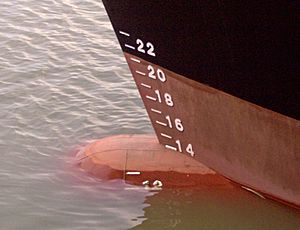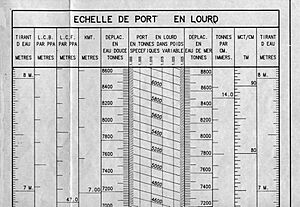Deadweight tonnage facts for kids
Deadweight tonnage (often shortened to DWT) is a way to measure how much weight a ship can safely carry. Think of it as the total weight a ship can hold, including everything it needs for a trip. This includes the cargo (the goods it's carrying), its fuel, fresh water, and even the weight of the passengers and crew.
DWT helps us know if a ship is carrying too much weight. Every ship has a special mark on its side called the Plimsoll line. When a ship is loaded to its maximum DWT, this line should be right at the water's surface. This shows that the ship is carrying its full, safe amount of weight.
What is Deadweight Tonnage?
Deadweight tonnage measures a ship's ability to carry weight. It does not include the weight of the ship itself when it's empty. This is different from "displacement," which is the total weight of the ship and everything in it, including the ship's own structure. It's also different from "gross tonnage," which measures the ship's internal volume, not its weight.
How is DWT Measured?
Historically, DWT was measured in "long tons." Today, it's usually measured in tonnes (which are also called metric tons). One tonne is 1,000 kilograms.
When experts calculate a ship's DWT, they look at how much water the ship pushes aside when it's fully loaded in seawater. Seawater has a specific density. They then subtract the weight of the empty ship. This gives them the exact deadweight tonnage. This measurement helps make sure ships are safe and don't carry more than they can handle.



